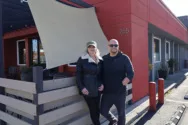
Home » PBS puts spotlight on Richland’s global miracle worker
PBS puts spotlight on Richland’s global miracle worker

May 13, 2021
A Richland nonprofit that works medical magic in the world’s most remote, undeveloped and dangerous corners is enjoying a moment in the spotlight, courtesy public television.
SIGN Fracture Care International, helmed by founder Dr. Lewis Zirkle and CEO Jeanne Dillner, is featured in “Trauma Healers,” a documentary that explores the need for trauma care in developing countries to prevent routine injuries from turning deadly or disabling.
It was distributed to more than 170 PBS stations May 4. Local viewers can tune into Northwest Public Broadcasting or NWPB at 2 p.m. May 23; 7 p.m. May 24; and 10 p.m. May 27.
Producers Patricia Fraley of Cincinnati, Ohio, and Robert Parish, of Portland, Oregon, made the documentary to draw attention to the “silent epidemic” of life-altering broken legs and other traumatic orthopedic injuries in “low resource countries.”
It’s more important now than ever with the world’s attention focused on fighting Covid-19.
The program promises to highlight what many Tri-Citians already know: SIGN Fracture Care International is a local feel-good story for its work to bring equipment and training to orthopedic surgeons in developing countries.
Zirkle, a well-known orthopedic surgeon, is fond of sharing the SIGN story with his neighbors. But its impact has drawn wide attention. In 2018, he was honored by a fellow Richlander, then-Secretary of Defense James Mattis, with the department’s Medal for Distinguished Public Service.
Zirkle, Mattis noted at the time, was spending his retirement traveling to developing countries and war zones – places that had been dealt a rough hand.
The mission
Zirkle established SIGN in 1999 with a singular mission to return injured people to healthy, productive lives, regardless of where they live. A broken leg is a painful nuisance in First World countries but can be a disabling, even life-ending, catastrophe in a developing one.
The mission is straightforward but carrying it out is more complicated. SIGN marries training, manufacturing and a vast global network of surgeons, all linked by a common database, to bring modern surgical techniques to doctors who often operate in primitive conditions.
SIGN designs and manufactures the implants and tools so surgeons can operate in places where electricity is unavailable or unreliable. X-ray equipment, for example, may not be available to guide doctors to injuries.
When he learned that First World tech didn’t work in Third World settings, Zirkle created devices that would in his garage shop.
SIGN’s work is funded chiefly by donations and some cost reimbursements. Its annual budget is about $6.7 million, with support from Kiwanis Clubs, Battelle, Kadlec Regional Medical Center and its longstanding partnership with the Seattle Foundation.
SIGN and its expanding network of surgeons operate in 54 – going on 55 – countries and have treated 350,000 patients injured in accidents and war. Its surgeons must report cases to SIGN’s database to get resupplied with implants. Zirkle reads and comments on them.

The database offers Dillner and Zirkle insights into procedures and into the growing number of surgeons and even nurses who are being trained in SIGN procedures by the people SIGN trained.
“I see new names in there all the time,” Zirkle said.
Pre-pandemic, the duo traveled three to four times a year, stopping in three countries per trip. It was a grueling schedule that’s now on hold. Unable to visit their sites in person, SIGN watches its impact spread through training from afar.
They embrace the process.
“To be a successful leader, you have to back off,” Zirkle said. “That’s what we’re doing.”
Changing lives
Naturally, Dillner and Zirkle have their favorite tales, which they shared via a recent Zoom interview.
For Dillner, who serves as SIGN’s chief executive officer, it is the pair of Marthas, one young and one old, whose lives could have been upended or even ended when they broke their legs in separate incidents.
The young Martha was 11 and an orphan living with her grandmother in Tanzania when her leg was broken when she was overrun in a street. In the normal course of events, she might have been taken to a local clinic and put in traction. It was unlikely she would have ever returned to school.
But young Martha had the good fortune to be taken to a SIGN pediatric hospital, where the surgeon successfully operated on her the next day.
Dillner befriended the girl, sponsoring her through boarding school. She graduated from high school in December, the first in her family. She’s alternating between becoming a doctor or an engineer.
The other Martha was over 60. She had been crawling around her farm attempting to maintain animals after a leg injury went untreated for years. The local SIGN-trained surgeon went to her village.
“Both Marthas were doing well – elderly Martha in her hut and little Martha in school getting straight A’s,” Dillner said.
Zirkle’s favorite stories tend to focus on the successes of “his” surgeons, like one operating in Myanmar, roiled now by revolution. Zirkle encouraged him to avoid politics and keep operating.
His favorite photo is a young man who broke his leg in a motorcycle crash there. He was the sole support for an extended family, including grandparents. He fully healed with SIGN’s implant, and Zirkle has his smiling photo to prove it.
He is proud too of the goodwill SIGN engenders. He recalls visiting a SIGN hospital in Afghanistan for a training session. The whole room was filled with surgeons who had traveled through battle zones to get there.
Men sitting on a fence at the entrance stared as the team walked in.
“Afghan men can really glare at you. They would glare at us.”
The nurse introduced them to an old man who had broken both legs falling in a well. Zirkle thought surgeons could help and insisted he be treated. The procedure was a success.
The next time they walked past the row of waiting men, they smiled.
“It’s a big way to win friends for the United States and personally,” he said. Returning the injured to good health benefits not just the individual but the people who depend on them. Dillner and Zirkle estimate the people treated by SIGN and its network of surgeons translates to
2 million people who were not left destitute because their provider was disabled.
“We’re helping real people who deserve an equal opportunity for healing. We’re providing these surgeons the tools they need to stay in their country and provide these services,” Dillner said.
SIGN is known for its “long bone” work, but it has expanded its mission into pediatric injuries, pelvic injuries and spinal injuries.
It has launched a fellowship program to train surgeons in pelvic fractures. It pays a stipend so participants are not forced to go into private practice. The program in Ethiopia trains a local surgeon and one from another country, with the expectation they will go home and train their peers.
It is also getting involved in spinal surgery.
“It’s going to be a big step for us. We tend to think big,” he said.
How does SIGN do it?
To understand how Zirkle and Dillner built a global network of orthopedic expertise, start at the start: Vietnam.
Zirkle, who studied medicine at Duke University, was drafted and sent to Vietnam shortly after he completed the first year of his orthopedic residency.
He was part of a team that rescued American and Vietnamese soldiers and Vietnamese civilians. The American casualties were sent to Japan or the U.S. for treatment. The civilians went to an ill-equipped local hospital.
“It wasn’t any good,” Zirkle recalled.
Opportunity knocked when a top commander was injured and treated in Zirkle’s hospital. The generals – William Westmoreland and Creighton Abrams Jr. – visited daily.
“I had to stand there each day like an idiot with a smile,” Zirkle said. He decided to get something out of the situation and asked the pair for permission to treat civilians in his own hospital. Zirkle got his “yes” within the week.
The work was popular with his medical colleagues. Implants and equipment were sent through back channels. Nurses and anesthesiologists gave their time.
“That was so rewarding to do that,” he recalled.
Zirkle returned home and set up a thriving medical practice in Richland, where he was the go-to doctor for routine broken bones and orthopedic injuries.
But he was drawn by the horrors he had seen in the war. He established SIGN in 1999 in Richland.
Today, it employs 44 where its team develops instruments that can be used in unsophisticated settings. He’s never regretted making Richland the center of the global network instead of a community with direct overseas flights.
“We have Alaska Airlines here. That’s enough,” he said.
Dillner said Richland is a good fit for recruiting employees. Researchers at the Pacific Northwest National Laboratory and Washington State University have helped out.
Students in WSU’s new medical school have signed on to assist with research in the engineering department.
“We never have problems finding people who have a commitment to the mission,” she said.
And they never run out of people who need help.
“There are so many patients in developing countries that need help,” Zirkle said.
Go to traumahealers.org for more information about the documentary and the producers’ work to highlight the need to prevent and heal orthopedic injuries in “low resource” countries.
Pelvic and spinal injuries are more difficult to treat than broken legs. But the consequences of going without treatment are even more dire. A badly healed pelvic injury can leave the patient permanently unable to walk and bed-ridden.
To learn more about SIGN, go to https://www.signfracturecare.org.
Local News
KEYWORDS may 2021





